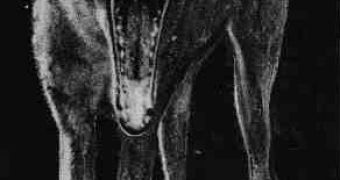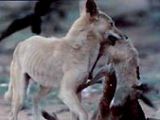After humans entered Australia, only two large carnivores roamed the lands: dingo and the Tasmanian "tiger" (thylacine).
The marsupial "tiger" (called so because of its striped back) or "wolf" (due to its superficial resemblance to a wolf or dog) stood about 60 cm (23.6 in) at the shoulder and weighed 20 to 30 kg (44-66 lb), while a dingo, which is a real wolf (or wild dog) is twice smaller: 10 to 24 kg (22-53 pounds) and is between 44 and 63 cm (17-25inches) high. But once again, strength resulted more important than size, enabling dingo to kill larger preys to outcompete the thylacine, as found by a new research.
The thylacine had a more powerful and efficient bite than the dingo, but it could not kill larger prey because of its weak ... neck! The neck differences enable the dingo, introduced 3,000 years ago by Malayo-Polynesians sailors in Australia to wipe out the 4 million years old thylacine.
This new research used complex computer simulations to assess bite forces and stress patterns applied by dingo and thylacine, based on skull mechanics and illustrating mechanical stresses and strains supported by the skull, jaw, teeth and cranial muscles of both animals while biting, tearing and shaking while grabbing and killing a struggling prey.
The same methodology (called finite element analysis) forecasts distortion and "failure" in load-bearing materials, like metal in the body and wings of an airplane.
"The thylacine has a greater bite force than the dingo but its skull becomes more stressed than the dingo under conditions that simulate the influence of struggling prey," said lead researcher Dr Stephen Wroe, UNSW paleontologist.
It appeared that the bigger marsupial meat eater could have smashed relatively easier small prey but it was confined to it, despite its larger size, because it could not subdue large prey.
"If the thylacine had been better able to hunt large prey, such as adult kangaroos and emus (as dingo do), as well as smaller species, then it would have faced less competition from the smaller dingo," said Wroe.
The dingo was also in advantage because of the social structure and hunting in packs (just like any other wolf), while the thylacine hunted all by itself. The thylacine's extinction on the Australian mainland could have been also hurried up by a climate change and a shift in Aboriginal land-use patterns.
It persisted only on the island of Tasmania, unreached by dingoes, until the European colonization, as it was believed the wolf-like carnivore could kill sheep (fact infirmed by this study).
Exported to zoos, killed by farmers and hunters (up to 2,000 government bounties were given between 1888 and 1912), the Tasmanian population of about 5,000 thylacines disappeared quickly: the last one died in a Tasmanian zoo in 1936. The settlers too competed with the thylacines for food, as they chased small animals, decreasing their numbers and induced environmental changes.

 14 DAY TRIAL //
14 DAY TRIAL // 
